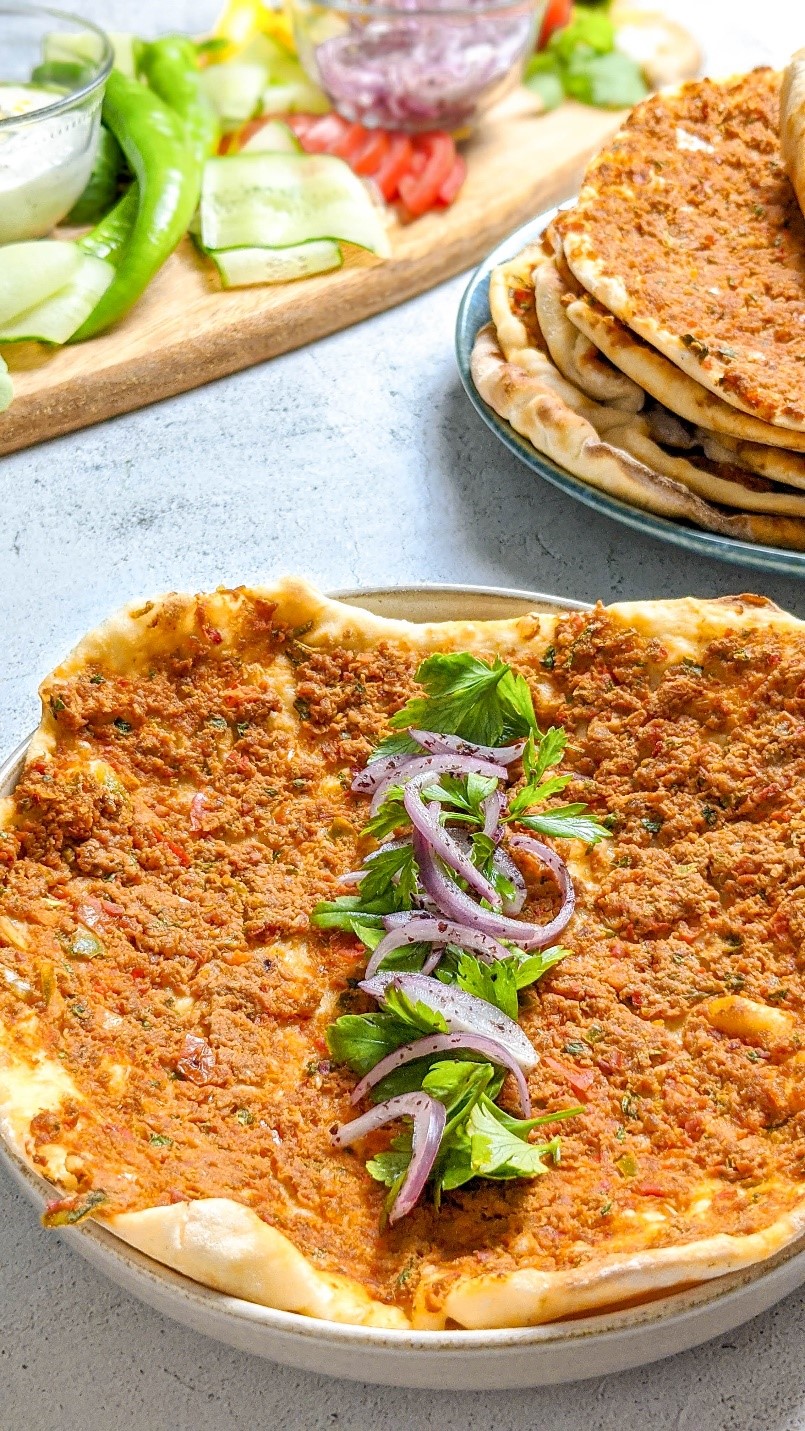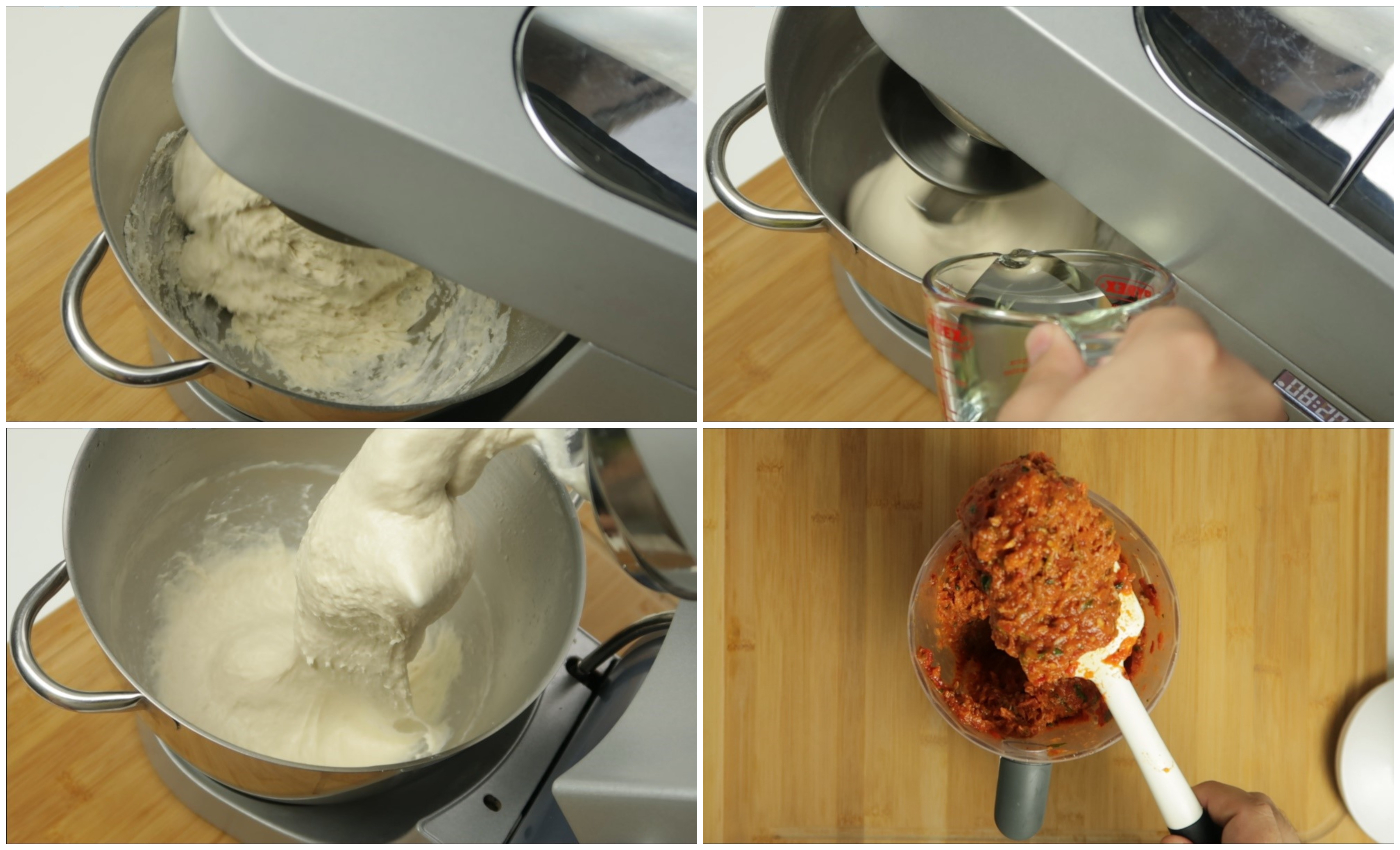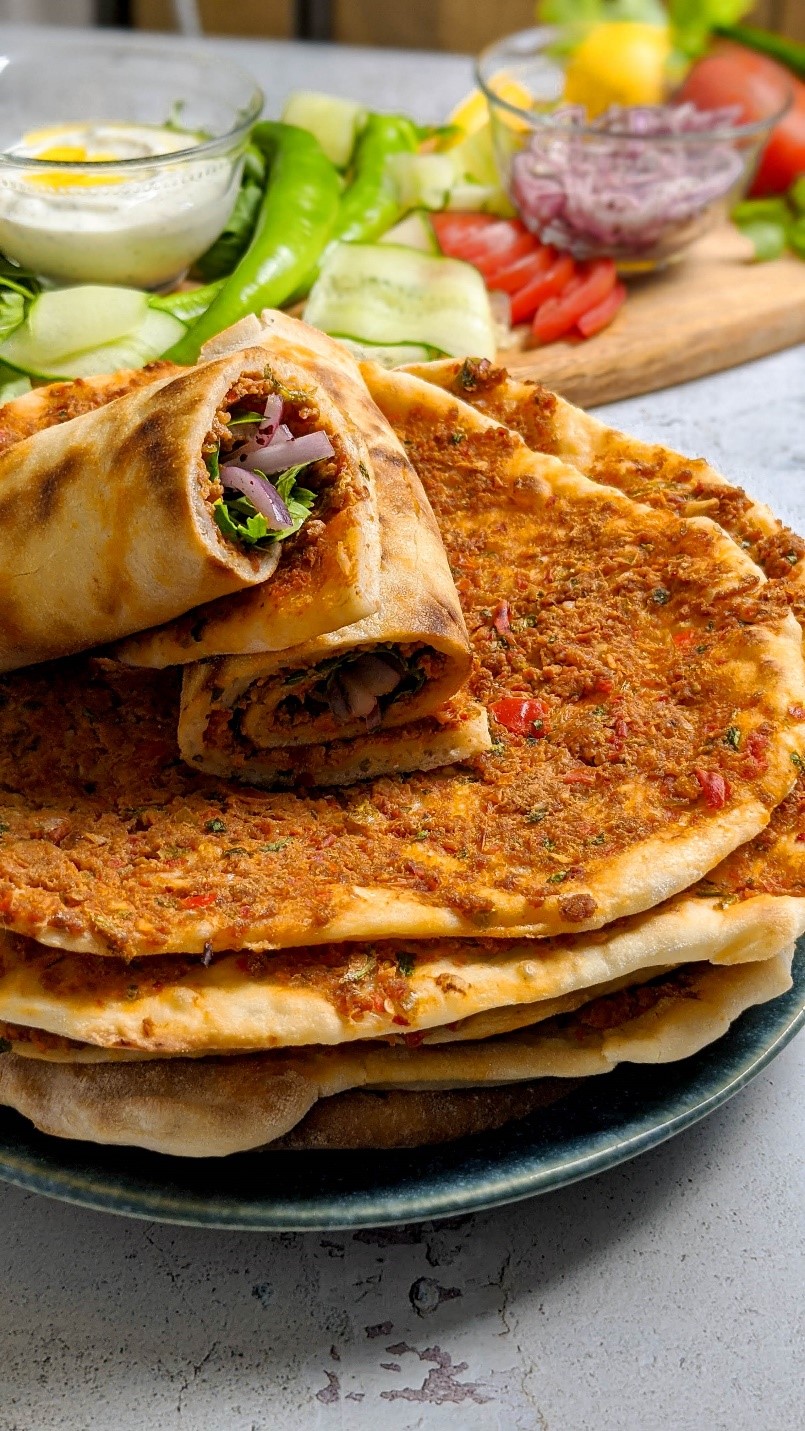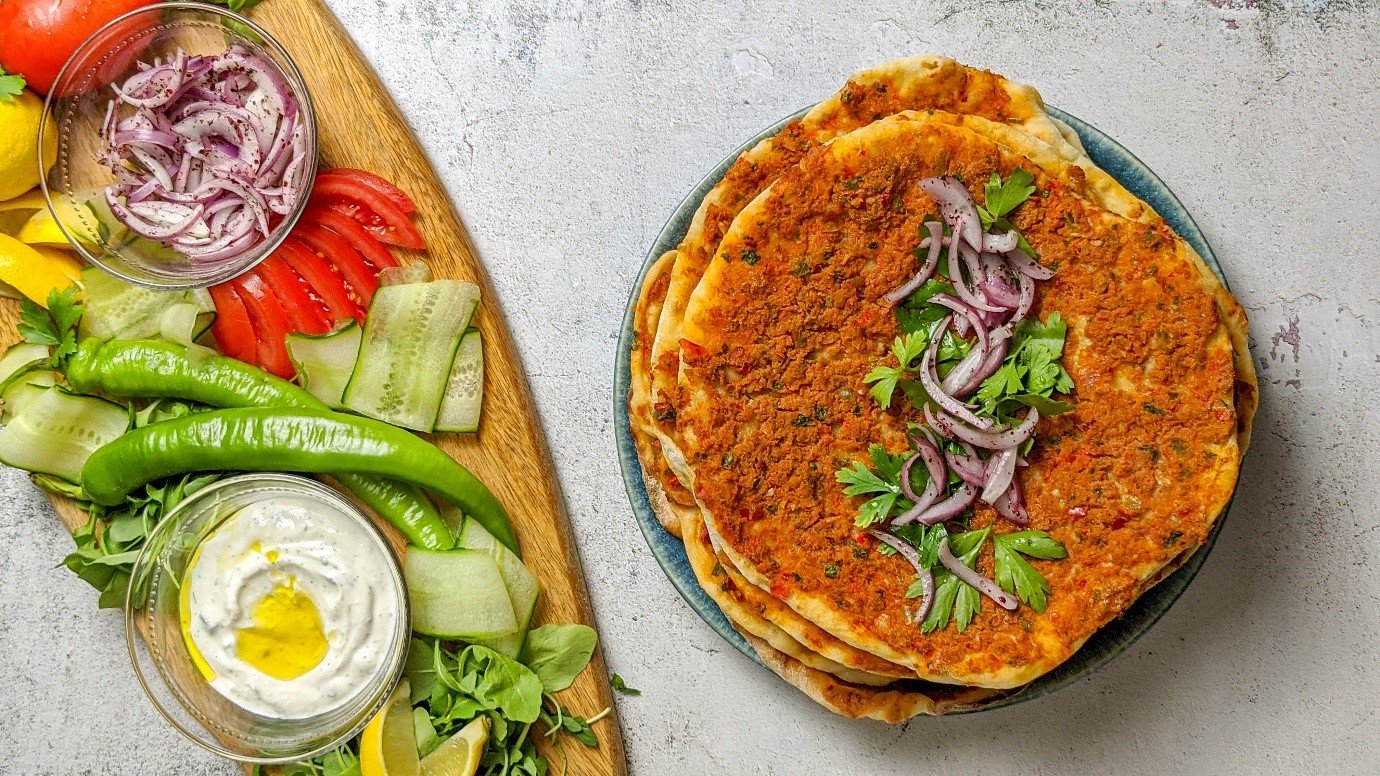Flatbreads exist in most Middle Eastern cuisine, from Moroccan msemen to Iranian taftoon. Every country has their own unique flatbreads, but one that is shared widely across borders is lahmacun. These meat-topped flatbreads are a quintessential staple in Turkey, the Levant and Armenia.
Lahmacun are thin flatbreads that are topped with a mixture of minced meat (lamb or beef), peppers, onions and tomatoes. The vegetables are minced finely until they almost form a paste and this is spread onto freshly rolled dough before baking. The result is a surprisingly light and refreshing bread that could work as a snack, or a main dish.
Other topped flatbreads of particular note in the region include manaeesh, pide and moajanat. These are usually topped with cheese, zaatar, spinach or meat. It has also become quite common to find hybrid versions, such as manaeesh with shawarma, pide with doner and moajanat with herby cream cheese. This Turkish recipe includes red pepper paste and pul biber (Aleppo chilli), which results in a delicious smokey and savoury flavour.
Recipe

Makes: Eight lahmachun
Preparation and Cooking Time: (1 hour + 1 hour rest time)
1. Ingredients
To make the dough
- 500g (1lb) all purpose flour
- 375ml (12.6 fl oz) whole milk, at room temperature
- 6 tbsp vegetable oil
- 1½ tsp instant yeast
- 1½ tsp salt
To make the meat topping
- 375g (0.75 lb) lamb mince (can also use beef)
- 2 plum tomatoes
- ½ brown onion
- ½ green pepper
- ½ red pepper
- 1 green chilli
- 3 cloves of garlic
- bunch of parsley
- 75g (2.65 oz) red pepper paste
- 50g (1.7 oz) tomato paste
- 1 tbsp pul biber or Aleppo chilli
- 1 tsp salt
- 30ml (1 fl oz) vegetable oil
To garnish
- Large bunch of parsley
- 1 red onion
- ½ tsp salt
- 1 tsp sumac
Extra toppings
- 2-4 lemons
- Any salad vegetables you like
2. Method
To make the dough:
You can make this by hand kneading the dough, but a stand mixer will be a lot easier.
- Pour your milk into a stand mixer with the dough hook attachment on.
- Add the instant yeast and mix for 30 seconds to combine.
- Add all of the flour and salt, then mix to combine until a dough ball forms. The dough will get very wet and sticky.
- When all the milk is absorbed into the dough, turn the mixer speed to high and knead for 5-8 minutes until the dough pulls away from the walls of the mixer bowl. Test the dough by touching it, if it sticks to your hand and leaves a little residue on your fingers but is springy, then it is ready.
- Add 1 tbsp of the oil to your dough at a time and work it in, this is easiest done by hand. The dough may start to slide around in your mixer, but work the dough until the oil is absorbed. Once absorbed repeat until all the oil is used.
- Grease a bowl with some vegetable oil and pour out your dough in it.
- Let it rest for 30-60 minutes until doubled in size.

To make the topping:
- Roughly chop the brown onion, green pepper, red pepper, plum tomatoes, green chilli and garlic.
- Add all the chopped ingredients to a food processor or blender, and then add in a handful of parsley.
- Add the salt, vegetable oil, pul biber (Aleppo chilli), tomato paste and red pepper paste.
- Process all the ingredients together, until a fine paste forms and the mixture is evenly textured and coloured. Taste for seasoning. The vegetable mixture should be over salted at this point, as the meat has yet to be added.
- Add the meat to the food processor and mix once more until it is well combined and a thick paste has formed.
To make the cured sumac onion garnish:
- Thinly slice a whole red onion and place in a bowl.
- Add half a teaspoon of salt and mix well to work into the onions.
- Add a teaspoon of sumac and mix to combine.
- Set aside for 15-30 minutes so the onions can cure.
To assemble and cook your lahmacun:
- Find your largest non-stick pan, take note of the inner diameter as this is the size you will roll your lahmacun out to.
- Pour your dough out onto a well-floured work surface and divide it into eight, equal-sized pieces.
- Select a piece of dough and roll it out into a thin circle using the following method: first flour both sides of the dough, then form it into a circle with your hand. Next take a small rolling pin, start in the centre of the dough and roll it away from you. When you reach the edges of the dough, lift the rolling pin up and reset it to the centre of the dough, then roll towards you. Continue to do this until you have reached the diameter of your pan, and then turn the dough 90 degrees to spread it from an oval, into a circle. It should be at a thickness of 2mm maximum. If the dough is larger than your pan, you may need to divide it into more pieces than eight.
- Transfer your dough to a well-floured plate or pizza peel.
- Add 2 – 3 tablespoons of topping to the dough. Spread the topping out into a thin even layer and get as close to the edges of the dough as possible.
- When ready to cook, heat your non-stick pan on medium high heat and preheat the grill on your oven.
- Fold your lahmacun in half to transfer it into the pan, unfold the lahmacun in the pan and re-distribute any topping which has moved.
- Let it cook for 2-3 minutes until the underside is just starting to brown and the topping starts to bubble slightly.
- Place the pan under your grill for 3-4 minutes until the topping is dry and well browned. Make sure to use a pan with metal handles, if you do not have one, you can transfer the lahmacun from your pan onto a baking tray lined with greaseproof paper instead.
- When the topping looks browned and cooked, remove the pan and place back on the stove until the underside of the lahmacun is evenly browned.
- When cooked, stack the lahmacun one on top of the other on a plate. This will help them re-moisturise and will soften the dough.
It is easiest to roll out one lahmacun at a time and cook it. While it is cooking prepare the next one.

To serve:
- Make sure to stack your lahmacun and let them rest for a few minutes if you would like to soften them so they can be rolled.
- Place a lahmacun on a plate and top with a handful of fresh parsley.
- Add some of the cured sumac onions.
- Squeeze on the juice of half a lemon.
- Add any salad vegetables you like.
- Roll up the lahmacun into a wrap and enjoy.

Notes: Rolling the dough extremely thin is a matter of skill. Using a smaller rolling pin helps to concentrate your weight into the dough and allows you to roll it out thinner. You should roll your dough as thin as you can get it without tearing. Some Turkish restaurants serve lahmacun the thickness of a coin, that is the thickness you want to aspire towards.
You can watch the full step-by-step video here:
You can follow Middle Eats for more recipes on their YouTube channel and Instagram page @middleeatsyt



